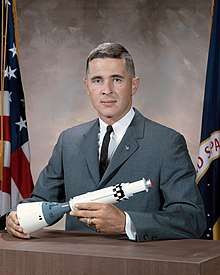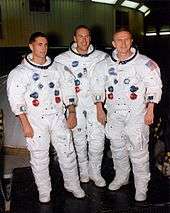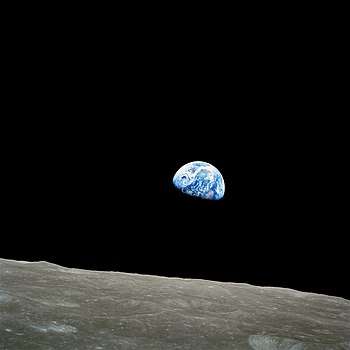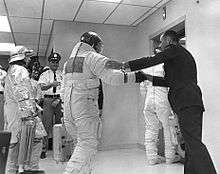Bill Anders
William Alison Anders (born October 17, 1933) is a retired United States Air Force major general, former electrical engineer, nuclear engineer, NASA astronaut, and businessman. In December 1968, as a crew member of Apollo 8, he was one of the first three people to leave low Earth orbit and travel to the Moon. Along with fellow astronauts Frank Borman and Jim Lovell, Anders circled the Moon ten times, and broadcast live images and commentary back to Earth. During one of the mission's lunar orbits he photographed the iconic image Earthrise.[1]
William A. Anders | |
|---|---|
 | |
| Born | William Alison Anders October 17, 1933 |
| Status | Retired |
| Nationality | American |
| Other names | Bill Anders |
| Alma mater | USNA, B.S. 1955 AFIT, M.S. 1962 |
| Occupation | Fighter pilot |
| Awards | |
| Space career | |
| NASA Astronaut | |
| Rank | |
Time in space | 6d 03h 00m |
| Selection | 1963 NASA Group 3 |
| Missions | Apollo 8 |
Mission insignia | |
| Retirement | September 1, 1969 |
| United States Ambassador to Norway | |
| In office May 11, 1976 – June 18, 1977 | |
| President | Gerald R. Ford Jimmy Carter |
| Preceded by | Thomas R. Byrne |
| Succeeded by | Louis A. Lerner |
Apart from his professional and military careers, Anders was the U.S. Ambassador to Norway from 1976 to 1977 under President Gerald Ford.
Early life and education
Anders was born on October 17, 1933, in British Hong Kong, to U.S. Navy Lieutenant Arthur Anders and his wife Muriel (née Adams) Anders.[2] Following Anders' birth, the family relocated from Hong Kong to Annapolis, Maryland where Anders' father began teaching mathematics at the U.S. Naval Postgraduate School. After a time, the family returned to China where Anders and his mother escaped to the Philippines following the Japanese attack of Nanking. With his mother, Anders started his journey to the Philippine Islands by troop train to Canton. While there, they stayed in a hotel 200 yards from a river the Japanese were bombing, the same river they were soon forced to travel in their escape.[3]
While in the United States, Anders was active in the Boy Scouts, achieving the organization's second-highest rank, Life Scout. As a teen, Anders attended St. Martin's Academy and Grossmont High School in El Cajon, California [4] during his sophomore and junior years. At Grossmont High, he developed several friendships, in particular with fellow members of the tennis team. But his grades weren't good enough, so he was sent to The Boyden School, a military academy prep school near Balboa Park located at the corner of 3rd and Elm Streets in downtown San Diego. "It was basically a school where you spent all day taking Naval Academy tests," he said. Anders commuted to Boyden's from La Mesa, Calif. "It was kind of a tough commute," he said. "I had to do it by bus." He thought the instruction was good, but he missed his friends at Grossmont.
Again, aircraft interrupted his concentration. "Consolidated Vultee was building the huge B-36, a 10-engine airplane," he said. "They would come in from Fort Worth and fly over our school. We were right under the flight path. All the pencils would jump up and down on the desks, and that's all you could hear." Planes like the B-36 would fly into Lindbergh Field and The Boyden School was located right under the final glide path for planes landing there. Anders graduated from Boyden in 1951.[5]
Following high school, he received an appointment to the United States Naval Academy, receiving a Bachelor of Science degree in electrical engineering in 1955. Upon graduation, he chose to be commissioned a Second Lieutenant in the United States Air Force. He then continued his studies, receiving a Master of Science degree in nuclear engineering from the U.S. Air Force Institute of Technology in 1962.[6] He attended Harvard Business School's six-week Advanced Management Program in 1979.[7]
Air Force service and NASA career
United States Air Force
Following graduation from the U.S. Naval Academy, Anders took his commission in the U.S. Air Force.[6] After receiving his pilot wings in 1956, he served as a fighter pilot in all-weather interceptor squadrons of the Air Defense Command in California and in Iceland, where he participated in early intercepts of Soviet heavy bombers who at the time were challenging America's air defense borders.[6] While at the Air Force Weapons Laboratory in New Mexico, he was responsible for technical management of nuclear power reactor shielding and radiation effects programs.[7]

NASA

In 1963, Anders was selected by NASA in the third group of astronauts.[7] While at NASA, he became involved in dosimetry, radiation effects, and environmental controls.[7] He was the backup pilot for the Gemini 11 mission.[7] Then in December 1968, he flew as Lunar Module Pilot for the Apollo 8 mission (although no lunar module was carried by the mission), the first mission where humans traveled beyond Low Earth orbit.[7] This was the first crewed flight to reach and orbit the Moon. Anders took a celebrated photograph of an Earthrise.[1] He served as the backup Command Module Pilot for the Apollo 11 mission, before accepting an assignment with the National Aeronautics and Space Council, while maintaining his astronaut status.[7] According to Anders:
We came all this way to explore the Moon, and the most important thing is that we discovered the Earth.[8][9]
On conservation of the planet, he said:
If you can imagine yourself in a darkened room with only one clearly visible object, a small blue-green sphere about the size of a Christmas-tree ornament, then you can begin to grasp what the Earth looks like from space. I think that all of us subconsciously think that the Earth is flat ... Let me assure you that, rather than a massive giant, it should be thought of as the fragile Christmas-tree ball which we should handle with considerable care.[10]
He was also on the back-up crew for Apollo 11 and, for a short time before he retired, was designated to be command module pilot on the crew scheduled for Apollo 14.[lower-alpha 1]
Post-NASA career
From 1969 to 1973, Anders served as Executive Secretary for the National Aeronautics and Space Council, which was responsible to the President, Vice President and Cabinet-level members of the Council for developing policy options concerning research, development, operations and planning of aeronautical and space systems.[7]
On August 6, 1973, he was appointed to the five-member Atomic Energy Commission, where he was lead commissioner for nuclear and non-nuclear power research and development. He was also named as U.S. Chairman of the joint U.S./USSR technology exchange program for fission and fusion power.[7]
Following the reorganization of national nuclear regulatory and developmental activities on January 19, 1975, he was named by President Ford to become the first chairman of the newly established Nuclear Regulatory Commission, which is responsible for nuclear safety and environmental compatibility. At the completion of his term as NRC chairman, he was appointed Ambassador to Norway and held that position until 1977. He then ended his career with the federal government after 26 years and began work in the private sector.[7]
He served briefly as a fellow of the American Enterprise Institute, then joined General Electric (GE) in September 1977. As Vice President and General Manager of GE's Nuclear Products Division in San Jose, California, he was responsible for the manufacture of nuclear fuel, reactor internal equipment, and control and instrumentation for GE boiling-water reactors at facilities located in San Jose and Wilmington, North Carolina. He also oversaw GE's partnership with Chicago Bridge and Iron for making large steel pressure vessels in Memphis, Tennessee. In August 1979, he attended Harvard Business School's six-week Advanced Management Program. On the first day of 1980, he was appointed General Manager of the GE Aircraft Equipment Division. Headquartered in Utica, New York, the division included more than 8,500 employees in five locations in the northeastern U.S. Its products included aircraft flight and weapon control systems, cockpit instruments, aircraft electrical generating systems, airborne radars and data processing systems, electronic countermeasures, space command systems, and aircraft/surface multi-barrel armament systems.[7]
In 1984, he left GE to join Textron as Executive Vice President for aerospace, and two years later became Senior Executive Vice President for operations.[7] In 1990, he became Vice Chairman of General Dynamics, and on January 1, 1991, its chairman and Chief Executive Officer. He retired in 1993, but remained Chairman until May 1994.[7]
Anders was a consultant to the U.S. Office of Science and Technology Policy, and was a member of the Defense Science Board and the NASA Advisory Council. He is a retired Major General in the USAF Reserve.[7]

He established the William A. Anders Foundation, a philanthropic organization dedicated to supporting educational and environmental issues. The foundation also founded the Heritage Flight Museum in 1996 in Bellingham, Washington. The museum moved to Skagit Regional Airport in Burlington, Washington in 2014; he serves as its President and until 2008 was an active participant in its air shows.[11]
The Anders crater on the Moon is named in his honor.[11]
In 2011, he spoke at the first Starmus Festival in the Canary Islands, delivering a lecture on the early American space program. His talk was published in the book Starmus: 50 Years of Man in Space.[12]
Organizations
Anders is a member of Tau Beta Pi National Engineering Honor Society, American Nuclear Society, American Institute of Aeronautics and Astronautics, and Society of Experimental Test Pilots.[7]
Personal life
Anders married Valerie Hoard in 1955.[7] Together, they have six children: Alan (born in 1957), Glen (born in 1958), Gayle (born in 1960), Gregory (born in 1962), Eric (born in 1964), and Diana (born in 1972). Anders continues to be active with the Heritage Flight Museum his charity founded, including flying vintage aircraft owned by the foundation at various airshows and aviation exhibitions. From his Air Force career on, he has logged more than 8,000 hours of flight time.[6] He and his wife reside in Anacortes, Washington.[3][13]
Anders stated that the Earthrise photograph "really undercut my religious beliefs. The idea that things rotate around the pope and up there is a big supercomputer wondering whether Billy was a good boy yesterday? It doesn't make any sense. I became a big buddy of Richard Dawkins."[14]
Awards and honors

- Air Force Distinguished Service Medal[7]
- Air Force Commendation Medal[7]
- NASA Distinguished Service Medal[7]
- Nuclear Regulatory Commission Distinguished Service Medal[7]
- National Geographic Society's Hubbard Medal for Exploration[7]
- Collier,[15] Harmon,[16] Dr. Robert H. Goddard[17] and General Thomas D. White USAF Trophies[18]
- Golden Plate Award of the American Academy of Achievement (1969)[19]
- American Astronautical Society's Flight Achievement Award[7]
- American Defense Preparedness Association's Industry Leadership Award (May 1993)[7]
- In October 2018, the International Astronomical Union named a crater seen in the Anders' photo as "Anders' Earthrise".[20]
Anders, along with his Apollo 8 crewmembers, received AIAA's Haley Astronautics Award.[21]
Anders was inducted into the International Space Hall of Fame in 1983,[9][22] the International Air & Space Hall of Fame in 1990,[23] the U.S. Astronaut Hall of Fame in 1997,[24][25] and the National Aviation Hall of Fame in 2004.[26]
In popular culture

Anders was portrayed by Robert John Burke in the 1998 HBO miniseries From the Earth to the Moon.[27]
He also appeared in the 2005 documentary Race to the Moon, which was shown as part of the PBS American Experience television series. The film, renamed in 2013 as Earthrise: The First Lunar Voyage, centered on the events that led up to the Apollo 8 mission.[28]
He is interviewed in a chapter of the book No More Worlds to Conquer by Chris Wright. The chapter is roughly evenly split between his life in the Apollo program and his later corporate life. The book's front cover is the famous Earthrise image taken by him.[29]
Anders appeared with fellow NASA astronauts Frank Borman and Jim Lovell on the C-SPAN channel book review, Rocket Men. He confirmed the story that he had fallen asleep while awaiting the Apollo 8 launch.[30]
Notes
- The crews for Apollo 14 and Apollo 13 were later swapped after he retired from NASA.
References
- "Chasing the Moon: Transcript, Part Two". American Experience. PBS. 10 July 2019. Retrieved 24 July 2019.
- Pace, Eric (2000-08-31). "Arthur F. Anders, 96, Hero Aboard U.S. Gunboat in 1937". The New York Times. Retrieved 2012-11-08.
- Freeze, Di (April 1, 2007). "Bill Anders: A Love of Afterburners". Airport Journals. Retrieved March 15, 2015.
- Newland, James (2010). La Mesa. Arcadia Publishing. p. 109.
- "Bill Anders: A Love of Afterburners" http://airportjournals.com/bill-anders-a-love-of-afterburners/
- "Maj. Gen. William A. Anders". Heritage Flight Museum. Archived from the original on October 30, 2012. Retrieved October 12, 2016.
- "William A. Anders (Major General, USAF Reserve, Ret.)". NASA Johnson Space Center. December 2014. Retrieved October 10, 2016.
- "Remarks by the President at the National Academy of Sciences Annual Meeting". WhiteHouse.gov. April 27, 2009. Archived from the original on June 3, 2015.
- "Lunar Module pilot on Apollo 8, the first mission to circumnavigate the Moon". nmspacemuseum.org. New Mexico Museum of Space History.
- Nicks, Oran W., ed. (1970). This Island Earth. NASA. p. 14.
- ""The First Earthrise" Apollo 8 Astronaut Bill Anders recalls the first mission to the Moon". The Museum of Flight. Retrieved October 13, 2016.
- "Starmus Festival and Stephen Hawking Launch the Book 'Starmus, 50 Years of Man in Space'". PR Newswire. September 7, 2014.
- "Skagit County Property Tax, Anders Bill; Anders Valerie". skagitcounty.net. 2013-04-22. Retrieved 2018-07-15.
- Sample, Ian (2018-12-24). "Earthrise: how the iconic image changed the world". The Guardian. ISSN 0261-3077. Retrieved 2018-12-24.
- "Apollo 8 Wins Collier Trophy". Alabama Journal. Montgomery, Alabama. Associated Press. May 9, 1969. p. 18 – via Newspapers.com.
- "AF Major, 3 Astronauts Get Harmon". Fort Lauderdale News. Fort Lauderdale, Florida. UPI. September 7, 1969. p. 67 – via Newspapers.com.
- "Paine Selected as NASA Chief". The San Francisco Examiner. San Francisco, California. Associated Press. March 5, 1969. p. 6 – via Newspapers.com.
- "The Gen. Thomas D. White USAF Space Trophy" (PDF). USAF. May 1997. p. 156. Cite magazine requires
|magazine=(help) - "Golden Plate Awardees of the American Academy of Achievement". www.achievement.org. American Academy of Achievement.
- Schulz, Rita. "Lunar craters named in honor of Apollo 8". EurekAlert!. International Astronomical Union. Retrieved 7 October 2018.
- "Apollo 8 Crew Honored". Florida Today. Cocoa, Florida. March 25, 1970. p. 12C – via Newspapers.com.
- Sheppard, David (October 2, 1983). "Space Hall Inducts 14 Apollo Program Astronauts". El Paso Times. El Paso, Texas. p. 18 – via Newspapers.com.
- Sprekelmeyer, Linda, editor. These We Honor: The International Aerospace Hall of Fame. Donning Co. Publishers, 2006. ISBN 978-1-57864-397-4.
- "U.S. Astronaut Hall of Fame". Astronaut Scholarship Foundation. Retrieved October 13, 2016.
- Meyer, Marilyn (October 2, 1997). "Ceremony to Honor Astronauts". Florida Today. Cocoa, Florida. p. 2B – via Newspapers.com.
- "Come With Us to Washington DC for the induction of the Class of 2018! - National Aviation Hall of Fame". National Aviation Hall of Fame. Retrieved 2018-06-18.
- James, Caryn (April 3, 1998). "Television Review; Boyish Eyes on the Moon". The New York Times. Retrieved August 5, 2018.
- Kertscher, Kevin Michael (October 20, 2005). "The Making of 'Race to the Moon': Apollo 8 Documentary Producer Tells All". Space.com. Retrieved November 16, 2016.
- "Anders' Game". Euromoney. June 2015. Retrieved November 16, 2016.
- "Rocket Men'". C-SPAN. April 2018. Retrieved June 20, 2018.
External links
| Wikimedia Commons has media related to William Anders. |
- Astronautix biography of William Anders
- Appearances on C-SPAN
- Bill Anders on IMDb
- US Air Force biography of William Anders
- American Experience, Race to the Moon
| Diplomatic posts | ||
|---|---|---|
| Preceded by Thomas R. Byrne |
United States Ambassador to Norway 1976–1977 |
Succeeded by Louis A. Lerner |
